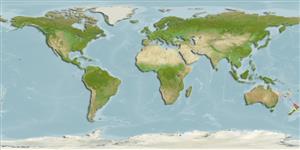Preferred temperature (Ref.
123201): 17.6 - 24.3, mean 20.2 °C (based on 13 cells).
Phylogenetic diversity index (Ref.
82804): PD
50 = 0.5002 [Uniqueness, from 0.5 = low to 2.0 = high].
Bayesian length-weight: a=0.00501 (0.00207 - 0.01214), b=3.15 (2.94 - 3.36), in cm total length, based on LWR estimates for this (Sub)family-body shape (Ref.
93245).
Trophic level (Ref.
69278): 3.5 ±0.37 se; based on food items.
Resilience (Ref.
120179): High, minimum population doubling time less than 15 months (Preliminary K or Fecundity.).
Fishing Vulnerability (Ref.
59153): Low vulnerability (10 of 100).
Nutrients (Ref.
124155): Calcium = 64.4 [28.6, 142.3] mg/100g; Iron = 0.69 [0.36, 1.50] mg/100g; Protein = 18.6 [15.6, 20.9] %; Omega3 = 0.174 [0.089, 0.335] g/100g; Selenium = 15.8 [6.4, 35.7] μg/100g; VitaminA = 84.9 [21.7, 435.5] μg/100g; Zinc = 1.17 [0.68, 2.06] mg/100g (wet weight);
